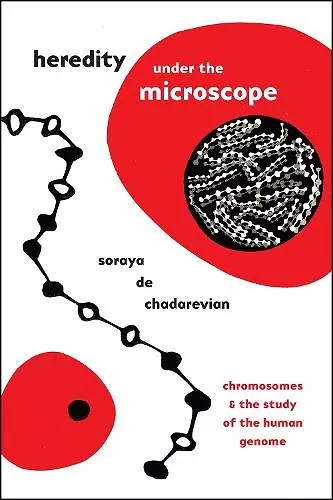Heredity under the Microscope
Chromosomes and the Study of the Human Genome
Format:Paperback
Publisher:The University of Chicago Press
Published:28th Aug '20
Should be back in stock very soon

By focusing on chromosomes, Heredity under the Microscope offers a new history of postwar human genetics. Today chromosomes are understood as macromolecular assemblies and are analyzed with a variety of molecular techniques. Yet for much of the twentieth century, researchers studied chromosomes by looking through a microscope. Unlike any other technique, chromosome analysis offered a direct glimpse of the complete human genome, opening up seemingly endless possibilities for observation and intervention. Critics, however, countered that visual evidence was not enough and pointed to the need to understand the molecular mechanisms.
Telling this history in full for the first time, Soraya de Chadarevian argues that the often bewildering variety of observations made under the microscope were central to the study of human genetics. Making space for microscope-based practices alongside molecular approaches, de Chadarevian analyzes the close connections between genetics and an array of scientific, medical, ethical, legal, and policy concerns in the atomic age. By exploring the visual evidence provided by chromosome research in the context of postwar biology and medicine, Heredity under the Microscope sheds new light on the cultural history of the human genome.
"The chromosome is at least as powerful an icon of heredity as DNA but so far has not held a central place in the historiography of twentieth-century life sciences. [Heredity under the Microscope] sets this record straight by directing its lense on the cytogenetic study of human chromosomes and the many contexts in which chromosome images came to matter. It opens fascinating new perspectives on the 'century of the gene' that go far beyond the earlier focus on the history of classical and molecular genetics." * British Society for the History of Science *
"Heredity under the Microscope presents an accurate and sweeping view of the role that cytogenetics played, not only in the history of science after World War II but also as the means by which the current molecular view of the human chromosome was achieved. . . . [de Chadarevian's] is the first story of human cytogenetics told from the historical point of view. . . . The discussions are broad and comprehensive, with careful attention to details. With a few exceptions, they present all the main events occurring in the era of cytogenetics. . . . What is most remarkable to this reviewer, is that the longest section of the book is the notes (67 pp.). This section documents the multitude of sources for what is written in the five chapters. De Chadarevian spoke with a horde of researchers and listened to a great number of interviews with relevant cytogeneticists, and refers to an enormous amount of printed material. Everything in the five chapters is more than adequately supported, and the notes are a delight to read. . . . She deserves our thanks for putting together such a comprehensive survey of human cytogenetics." * FASEB Journal *
"A fascinating read on the development of postwar human genetics. . . . This highly readable and impressive book demonstrates the overlapping concerns of science, medicine, law, and policy in the atomic age. De Chadarevian argues that the earlier microscopic research was central to the approach to studying human genetics. This book is a richly sourced survey of human cytogenetics and would be useful for undergraduate teaching." * Journal of the History of Ideas blog *
"De Chadarevian's book fully meets its main goal: that of reintroducing chromosomes and cytogenetics into a still simplistic narrative of the history of the understanding of human heredity that traverses the twentieth century. . . . It is a most welcome development in the history of biology." * H-Sci-Med-Tech *
"Images of the human chromosomes have enchanted scientists, inspired artists, and become symbols of human difference and pathology. In her engaging account, Soraya de Chadarevian deftly explores the visualization of these cellular 'colored bodies' and demonstrates their critical role in modern biology. The 'molecular revolution,' she suggests, was also a chromosomal revolution." -- M. Susan Lindee, University of Pennsylvania
"De Chadarevian shows how much we have missed by looking at the history of biology since World War II as largely a history of how molecular geneticists cracked the genetic code. By focusing the lens on chromosomes, and their uses inside and outside the laboratory, her thorough yet elegant account exposes unexpected continuities, both with the eugenic past of heredity research and its genomic present." -- Staffan Müller-Wille, coauthor of The Gene: From Genetics to Postgenomics
"Here we see most vividly how researchers debated the meanings and validity of visual evidence. Heredity Under the Microscope is a remarkable account of what was at stake in visualizing chromosomes." * Journal of the History of Biology *
"The book is interesting, informative, and meticulously researched—a must-read
for scientists and science studies scholars interested in the history of twentieth-century genetics. Chadarevian’s writing style is accessible and engaging, which also makes the book suitable for nonacademics. The argument, spread over five chapters, is nuanced and compelling." * Isis *
ISBN: 9780226685113
Dimensions: 229mm x 152mm x 20mm
Weight: unknown
272 pages